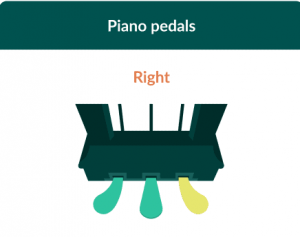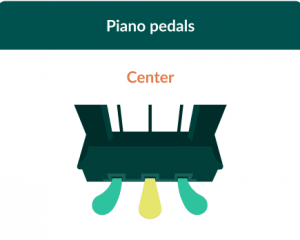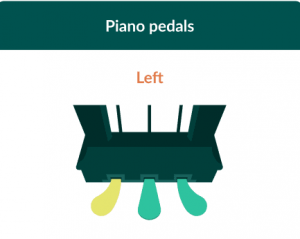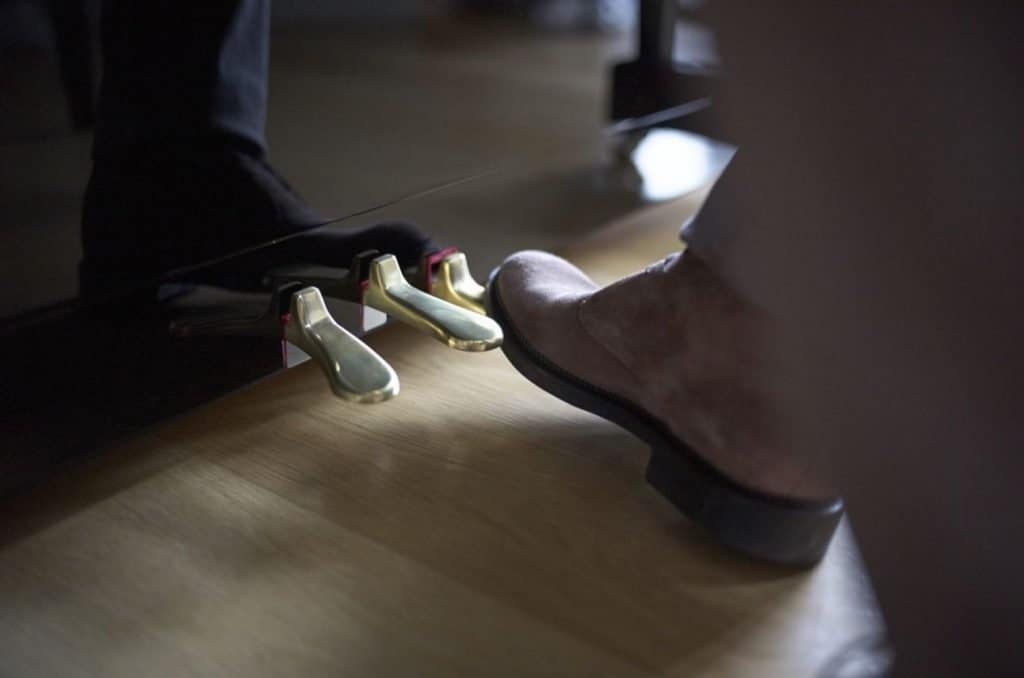When you sit in front of a grand piano, your eyes are drawn not only to the keys but also to the three pedals at your feet. But what do the piano pedals do? These pedals play a crucial role in shaping the sound and expression of the piano.
Whether you’re a novice or an experienced pianist, understanding the functions of these pedals and how to use them can elevate your playing. In this article, we will explore the world of piano pedals and learn how to unlock the true potential of your instrument.

What do the pedals on a piano do?
Piano pedals allows pianists to manipulate the duration, sustain and tonal quality of the notes they play. Each pedal serves a distinct purpose, providing a range of expressive possibilities. Let’s dive into the individual functions of these pedals.
Types of piano pedals
Pianos typically have either two or three pedals. Not every piano has all three pedals and some variation exists whether you have a grand piano or an upright piano. Some digital pianos don’t come with any foot pedals at all.
Learning what each of the three pedals on a piano do and learning how to read the pedal markings on sheet music is a necessary step on every pianist’s journey.
The piano pedals names are:
- The sustain pedal, damper pedal, or right pedal
- The practice pedal, sostenuto pedal or center pedal
- The soft pedal, una corda pedal, or left pedal
1. Sustain pedal ➡️ (Right)
The sustain pedal, also known as the damper pedal, is the most frequently used pedal on a piano. Positioned on the right side, this pedal is typically operated with the right foot. When you press down on the sustain pedal, it lifts the dampers from the strings, allowing the piano notes to resonate freely. This creates a sustained sound, even after the keys are released, giving the music a rich and full-bodied quality.

In the nineteenth century, the sustain pedal became an essential part of the piano’s sound. If you’re eager to learn how to incorporate this technique while playing Beethoven’s ‘Für Elise’, you can check out our comprehensive ‘Für Elise’ tutorial right here on Skoove! This tutorial will guide you step-by-step through the mesmerizing melody and help you master the nuances of this timeless composition.
Learn how to play ‘Für Elise’ by Ludwig van Beethoven. Start a 7 day trial today – no card details required!
2. Sostenuto pedal ↔️(Center)
The sostenuto pedal is the middle pedal and is the least used of the three pedals. When pressed, it sustains only the notes that are being held down at that precise moment. This allows pianists to sustain specific melodies or chords while other notes played afterward are unaffected. The sostenuto pedal adds depth and complexity to musical passages, enabling a multilayered and nuanced performance.

There is a variation in this middle pedal that simply deadens the sound of the piano. It is then called the practice pedal, since it makes the acoustic piano sound much quieter.
3. Soft pedal ⬅️ (Left)
The third pedal, the soft pedal, also called the una corda pedal, is located on the left side of the piano. Contrary to its name, the soft pedal does not directly affect the volume of the instrument. Instead, it alters the tonal quality of the notes.
When the soft pedal is engaged, the hammers strike fewer strings, resulting in a mellow and delicate sound. This pedal is particularly useful when playing gentle or introspective pieces. The soft pedal creates a beautiful, if sometimes fragile, sound.

Whenever you see the instruction pp, pianissimo, or una corda you are being instructed to use this foot pedal on a piano. This pedal is often used in the piano music of French composer Claude Debussy.
You can practice using the soft pedal on Skoove’s arrangement of the traditional melody‘Greensleeves’.
Learn how to play ‘Greensleeves’ on piano. Start a 7 day trial today – no card details required!
Other pedals
Most MIDI keyboards have a ¼” input jack labeled “sustain,” allowing players to easily connect a standalone sustain pedal. Many sampled piano plug-ins now offer these functions to help simulate the full range of acoustic pedal effects.
Additionally, most digital upright and grand pianos come equipped with a three-pedal setup sustain, soft, and sostenuto which matches the traditional arrangement on acoustic pianos. This setup enables pianists to fully explore nuanced expressions and dynamics, making digital and sample based pianos an increasingly complete alternative for performers and students alike.
How to use the piano pedals?
Now that we have an understanding of the different piano pedals and their functions, let’s explore how to use them effectively. Mastering the art of pedal technique will open up a world of expressive possibilities while learninghow to play piano.
Before we dive into the specific uses of each pedal, it’s important to understand the proper pedal technique. When using the pedals, try to keep your foot movements smooth and controlled. Avoid excessive force or sudden movements that can disrupt the flow of the music. With practice, you’ll develop a natural and effortless pedal technique.
1. Sustain pedal technique
Using the sustain pedal correctly is essential for achieving a beautiful legato and creating a seamless transition between chords. Here’s a step-by-step guide on how to use the sustain pedal:
| 1️⃣ | Start by positioning your foot above the sustain pedal. |
| 2️⃣ | As you press the keys to play a note or chord, simultaneously depress the pedal with your foot. |
| 3️⃣ | Keep the pedal depressed as you play subsequent notes or chords, allowing the sound to sustain. |
| 4️⃣ | Release the pedal when you want the sound to stop resonating. |
Remember to use the sustain pedal judiciously, as excessive or inappropriate pedal usage can muddy the sound or blur the intended musical phrases.
2. Sostenuto pedal technique
While the sostenuto pedal is less commonly used, it adds a unique touch to certain musical passages. Here’s how to employ the sostenuto pedal effectively:
| 1️⃣ | Before playing the desired notes or chords that you want to sustain, depress the sostenuto pedal and hold it down. |
| 2️⃣ | Release the keys you wish to sustain while keeping the sostenuto pedal depressed. |
| 3️⃣ | Continue playing other notes or piano chords without affecting the sustained ones. |
| 4️⃣ | Lift your foot off the sostenuto pedal to release the sustained notes. |
By using the sostenuto pedal strategically, you can create beautiful harmonies and intricate musical textures.
3. Soft pedal technique
The soft pedal is often used to create contrast or evoke a specific mood in a musical piece. Here’s how to use the soft pedal effectively:
| 1️⃣ | When you want to apply the soft pedal, slide your foot to the left side of the piano and press down on the soft pedal. |
| 2️⃣ | While playing, notice the subtle change in tonal quality, as the sound becomes gentler and more intimate. |
| 3️⃣ | To return to the normal position, release the soft pedal by lifting your foot. |
| 4️⃣ | Notice how varying the speed of the application/release of the soft pedal changes the tone. |
Experiment with the soft pedal to explore the different shades of expression it can bring to your music.
How to read pedal notation?
Reading piano pedal markings in sheet music is quite easy once you understand the symbols used.
When a piece of music calls for the damper pedal, we see this symbol under the music:

Basically, all this means is push down the damper pedal and lift it each time the line line is broken. In notated music, it looks like this:

In this example, you push down the damper pedal at the start of the phrase, lift it at the high E♭, push the pedal back down again and lift it again finally on beat 4 of the second measure with the rest. Easy, right? Try it with someeasy piano songs!
These pedal markings are the same for an upright piano or a grand piano.
Mistakes to avoid when using piano pedals
When learning to use piano pedals effectively, it’s helpful to avoid common mistakes that can detract from your performance. Here are key pitfalls to watch for:
- Over-pedaling: Constant pedal use can cause a blurred, muddy sound. Lift the pedal briefly when changing harmonies to maintain clarity.
- Late pedal release: Releasing the sustain pedal too late can create dissonance. Release it slightly before switching chords for a cleaner transition.
- Incorrect timing: Syncing pedal changes with musical phrases is essential. Practice coordinating hands and feet for precise timing.
- Excessive pedal depth: Pressing the pedal too deeply can produce a muddy tone. Aim for a moderate, controlled depth.
- Neglecting the soft pedal: The soft pedal adds subtle dynamics and depth. Experiment with it to enhance expression.
- Foot control: Avoid stomping or lifting your heel, which can reduce control. Keep your foot relaxed, using the ball to apply pressure.
- Pedal markings and era-appropriate usage: Use pedal markings as a guide, but adjust based on interpretation and the piece’s style. Romantic music often uses more pedal, while Baroque music generally uses less.
By focusing on these techniques and practicing patiently, you’ll refine your pedal skills, achieving a more polished, expressive sound.
Pedal your way to musical greatness!
Understanding piano pedals is essential for every pianist, by mastering each pedal’s function you can unlock new expressive possibilities in your piano playing. Take time to practice and experiment with different pedal techniques to enhance your interpretations.
For a practical way to develop these skills, try the Skoove app, which offers lessons featuring real songs where you can practice and refine your pedal technique. Learn to play like your favorite musicians by starting a free trial with Skoove today.
Author of this blog post:
Alvin Shipp

Published by Lydia Ogn from the Skoove team














